Social Cluster and Heritage Memory: A Study on the Space Perception of Zhaozhou Basin Horse Caravan Vernacular Architecture
Abstract
1. Introduction
2. Theoretical Basis and Research Model
2.1. Theory of Space Perception
2.2. Theoretical Models and Assumptions
3. Study Method Design
3.1. Study Sample Site
3.2. Scale Design and Data Collection
3.2.1. Survey Sample
3.2.2. Hypothesis Development through Observation
3.2.3. Model Measurement Scale Design
4. Analysis Methods: Model Validation and Result Analysis
4.1. Common Method Bias Test
4.2. Model Test
4.2.1. Model Fit Analysis
4.2.2. Direct Path Test Results
4.3. Results Analysis
5. Discussion and Conclusions
5.1. Discussion
5.2. Conclusions
6. Limitations and Future Research
Author Contributions
Funding
Data Availability Statement
Conflicts of Interest
References
- UNESCO. Universal Declaration on Cultural Diversity; Law Press: Beijing, China, 2006. [Google Scholar]
- The State Administration of Cultural Heritage. Selected International Cultural Heritage Protection Document; Cultural Relics Press: Beijing, China, 2007; p. 173. [Google Scholar]
- Wang, J.; Wen, F.; Fang, D. Intangible Cultural Heritage Tourism and the Improvement of Rural Environment in China: Value Cocreation Perspective. IOP Conf. Ser. Earth Environ. Sci. 2019, 237, 5. [Google Scholar] [CrossRef]
- Ministère de la Culture et de la Communication. Available online: https://structurae.net/en/companies/ministere-culture-communication (accessed on 7 December 2023).
- Gigot, M. Les zones de protection du patrimoine architectural, urbain et paysager (ZPPAUP), une forme de gouvernance pat-rimoniale. Cult. Local Gov. 2008, 1, 47–62. [Google Scholar] [CrossRef]
- Yu, S. French Heritage Protection and Value Reproduction of Architecture, Cities and Landscape Heritage; Tongji University Press: Shanghai, China, 2010; p. 127. [Google Scholar]
- Dolores, L.; Macchiaroli, M.; Mare, D.G. Sponsorship for the Sustainability of Historical-Architectural Heritage: Application of a Model’s Original Test Finalized to Maximize the Profitability of Private Investors. Sustainability 2017, 9, 1750. [Google Scholar] [CrossRef]
- Xiaoyong, F. Road Transportation Plan of Wudadao Sightseeing Streets Historical Blocks in Tianjin; China Society of Urban Science; Urban Development Research; International Forum on Urban Development and Planning; Tianjin Urban Planning and Design Research Institute: Tianjin, China, 2009. [Google Scholar]
- Yang, Y.; Xiong, Y.; Shen, R.Y. Renew and Extension of Vigor in Historical Block—The Background Study of Historical Block and the Building Overhang Protection and Synthesis Reform in Haikou. Appl. Mech. Mater. 2011, 99–100, 126–130. [Google Scholar] [CrossRef]
- Zhang, H.; Wang, F.; Guo, F.; Cai, J.; Dong, J. Urban architectural cultural relics protection and realistic dilemma: Development process, protection system and critical thinking of Dalian historical district. Archit. Herit. 2023, 7, 12–22. [Google Scholar]
- Guo, C. A Study about the Traditional Heritage Assessment System for Historical Architecture. Architectural History Branch of Architectural Society of China, Tongji University (Tongji University). Chinese Architectural Heritage from a global perspective. In Collection of the 4th International Symposium on Chinese Architecture History (Series 4); School of Architecture and Urban Planning, Tongji University: Shanghai, China, 2007; p. 4. [Google Scholar]
- Yang, Y. Renascence of Urban Industrial Heritages on the Background of Creative Industry Development. Adv. Soc. Sci. Educ. Humanit. Res. 2017, 103, 467–471. [Google Scholar]
- Rusnak, M.; Szmigiel, M.; Geniusz, M.; Koszewicz, Z.; Magdziak-Tokłowicz, M. Exploring the impact of cultural context on eye-tracking studies of architectural monuments in selected European cities: Sustainable heritage management. J. Cult. Herit. 2024, 66, 326–342. [Google Scholar] [CrossRef]
- Pierdicca, R.; Paolanti, M.; Quattrini, R.; Mameli, M.; Frontoni, E. A visual attentive model for discovering patterns in eye-tracking data—A proposal in cultural heritage. Sensors 2020, 20, 2101. [Google Scholar] [CrossRef]
- Li, N.; Zhang, S.; Xia, L.; Wu, Y. Investigating the Visual Behavior Characteristics of Architectural Heritage Using Eye-Tracking. Buildings 2022, 12, 1058. [Google Scholar] [CrossRef]
- Rusnak, M. Eye-tracking support for architects, conservators, and museologists. Anastylosis as pretext for research and discussion. Herit. Sci. 2021, 9, 81. [Google Scholar] [CrossRef]
- Landorf, C. A framework for sustainable heritage management: A study of UK industrial heritage sites. Int. J. Herit. Stud. 2009, 15, 494–510. [Google Scholar] [CrossRef]
- Li, J.; Krishnamurthy, S.; Roders, A.P.; van Wesemael, P. Informing or consulting? Exploring community participation within urban heritage management in China. Habitat Int. 2020, 105, 102268. [Google Scholar] [CrossRef]
- Vicente-Gilabert, C.; Del Espino-Hidalgo, B.; Del Pulgar, M.L.G. Bridging Heritage and Citizens: A Methodological Consultation-Based Approach. Hist. Environ. Policy Pract. 2024, 15, 221–247. [Google Scholar] [CrossRef]
- Kim, H.-J. A Study on Shanghai’s Strategies for Cultural Urban Regeneration through Industrial Heritage—Focused on M50 Creative Industrial District. J. Chin. Stud. 2013, 65, 321–347. [Google Scholar]
- Mirmoradi, S. The effect of the relationship between indoor architectural design studios and outdoor landscape on increasing students’ satisfaction level. Int. J. Built Environ. Sustain. 2021, 8, 47–56. [Google Scholar] [CrossRef]
- Casakin, H.; Davidovitch, N. Social-academic climate and academic satisfaction in architectural design education. Probl. Educ. 21st Century 2013, 56, 16. [Google Scholar] [CrossRef]
- Sun, R. Motivational representations within a computational cognitive architecture. Cogn. Comput. 2009, 1, 91–103. [Google Scholar] [CrossRef]
- Beardsley, E.; Burroughs, S.; Crowhurst, D. Building Sustainability Assessment and Benchmarking—An Introduction; United Nations Settlements Programme (UN-Habitat): Nairobi, Kenya, 2017. [Google Scholar]
- Huisheng, S. Between the Formal and Informal: Institutions and Village Governance in Rural China. Int. J. 2015, 13, 24–44. [Google Scholar]
- Heelan, P.A. Space-Perception and the Philosophy of Science; University of California Press: Berkeley, CA, USA, 2023. [Google Scholar]
- Lin, Z.; Jiao, W.; Liu, H.; Long, T.; Liu, Y.; Wei, S.; He, G.; Portnov, B.A.; Trop, T.; Liu, M.; et al. Modelling the public perception of urban public space lighting based on SDGSAT-1 glimmer imagery: A case study in Beijing, China. Sustain. Cities Soc. 2023, 88, 104272. [Google Scholar] [CrossRef]
- Mura, A.L.; Nonnis, M.; Scrima, F.; Fornara, F. Promoting the work engagement of the health worker: The role of secure workplace attachment, perceived spatial-physical comfort, and relationship with patients. J. Environ. Psychol. 2023, 23, 17–21. [Google Scholar] [CrossRef]
- Wu, C.; Ye, Y.; Gao, F.; Ye, X. Using street view images to examine the association between human perceptions of locale and urban vitality in Shenzhen, China. Sustain. Cities Soc. 2023, 2, 15–24. [Google Scholar] [CrossRef]
- Skill, K.; Farhangi, M.; Trygg, K. Size matters: Action space for sustainability transition among planners in Swedish municipalities. Urban Res. Pract. 2023, 7, 329–346. [Google Scholar] [CrossRef]
- Xing, R. Allegorical Architecture: Living Myth and Architectonics in Southern China; University of Hawaii Press: Honolulu, HI, USA, 2007. [Google Scholar]
- Yang, G. Communication and Space; China State Architecture Publishing House: Beijing, China, 2002; pp. 24–40. [Google Scholar]
- Zhai, Y.; Li, K.; Liu, J. A Conceptual Guideline to AgeFriendly Outdoor Space Development in China How Do Chinese Seniors Use the Urban Comprehensive Park A Focus on Time Place and Activities. Sustainability 2018, 10, 3678. [Google Scholar] [CrossRef]
- Jones, S. Wrestling with the social value of heritage: Problems, dilemmas and opportunities. J. Community Archaeol. Herit. 2017, 4, 21–37. [Google Scholar] [CrossRef]
- Liu, D. Introduction to Chinese Housing; Baihua Literature and Art Publishing House: Tianjin, China, 2004. [Google Scholar]
- Rong, W.; Bahauddin, A. A Bibliometric Review of the Development and Challenges of Vernacular Architecture within the Urbanisation Context. Buildings 2023, 13, 2043. [Google Scholar] [CrossRef]
- Hair, J.F. Multivariate Data Analysis; Prentice Hall: Upper Saddle River, NJ, USA, 2010; p. 785. [Google Scholar]
- Eisinga, R.; Grotenhuis, M.; Pelzer, B. The Reliability of a Two-Item Scale: Pearson, Cronbach, or Spearman-Brown. Int. J. Public Health 2013, 58, 637–642. [Google Scholar] [CrossRef]
- Fornell, C.; Larcker, D.F. Evaluating Structural Equation Models with Unobservable Variables and Measurement Error. Wash. J. Mark. Res. 1981, 18, 39–50. [Google Scholar] [CrossRef]
- Liu, Y.; Zhao, Z.B.; Li, X.Y. Landscape Value in Rural Community Based on PPGIS: A Case Study on Shuhe Old Town of Lijiang. Sci. Geogr. Sin. 2021, 41, 328–339. [Google Scholar]
- Milman, A. Evaluating the Guest Experience at Theme Parks: An Empirical Investigation of Key Attributes. Int. J. Tour. Res. 2009, 11, 373–387. [Google Scholar] [CrossRef]
- Lu, Y. A multi-objective optimisation algorithm for rural tourism route recommendation. Int. J. Inf. Commun. Technol. 2022, 21, 197–212. [Google Scholar]
- Manavvi, S.; Rajasekar, E. Assessing thermal comfort in urban squares in humid subtropical climate: A structural equation modelling approach. Build. Environ. 2023, 229, 109931. [Google Scholar] [CrossRef]
- Bae, K.B. The differing effects of individual-and group-based pay for performance on employee satisfaction: The role of the perceived fairness of performance evaluations. Public Manag. Rev. 2023, 25, 601–619. [Google Scholar] [CrossRef]
- Jeelani, P.; Shah, S.A.; Dar, S.N.; Rashid, H. Sustainability constructs of mountain tourism development: The evaluation of stakeholders’ perception using SUS-TAS. Environ. Dev. Sustain. 2023, 25, 8299–8317. [Google Scholar] [CrossRef]
- Alt, D.; Kapshuk, Y.; Dekel, H. Promoting perceived creativity and innovative behavior: Benefits of future problem-solving programs for higher education students. Think. Ski. Creat. 2023, 47, 101201. [Google Scholar] [CrossRef]
- Liu, Y.; Fu, B.; Wu, X.; Wang, S.; Yao, Y.; Li, Y. The community perception of human-water connections is indirectly influenced by the landscape context: A case study in the lower reaches of the Yellow river. J. Environ. Manag. 2023, 326, 116644. [Google Scholar] [CrossRef] [PubMed]
- Yang, Y.; Chen, Y.; Liu, Y.; He, T.; Chen, L. Evaluation and Optimization of Cultural Perception of Coastal Greenway Landscape Based on Structural Equation Model. Int. J. Environ. Res. Public Health 2023, 20, 2540. [Google Scholar] [CrossRef]
- MacKay, D.M. Theoretical models of space perception. In Aspects of the Theory of Artificial Intelligence the Proceedings of the First International Symposium on Biosimulation Locarno, Locarno, Switzerland, 29 June–5 July 1960; Springer: Boston, MA, USA, 1960; pp. 83–103. [Google Scholar]
- Ni, C.Q.; Zhang, Y.Q.; Chen, C.W. The impact of landscape perception on tourists’ willingness to revisit the rural boutique line. Landsc. Archit. 2023, 3, 100–108. [Google Scholar]
- Zhou, H.; Long, L. Statistical test and control method of deviation of common methods. Adv. Psychol. Sci. 2004, 6, 942–950. [Google Scholar]
- Gong, H.; Hui, J.; Tian, G. Revision of the Juvenile Self-Compassion Scale and its reliability and validity test. Psychol. Res. 2014, 7, 36–40+79. [Google Scholar]
- Tian, S.Q.; Xie, W.D.; Chen, L. Analysis of farmers’ willingness and influencing factors in hollow villages in urban suburbs—Take 17 villages in 5 counties (cities and districts) of Chengdu as examples. Soil Water Conserv. 2017, 8, 12–18. [Google Scholar]
- Loomis, J.M.; Da Silva, J.A.; Fujita, N.; Fukusima, S.S. Visual space perception and visually directed action. J. Exp. Psychol. Hum. Percept. Perform. 1992, 18, 906. [Google Scholar] [CrossRef]
- Zheng, L.; Zhao, Y.; Duan, R.; Yang, W.; Wang, Z.; Su, J. The influence path of community green exposure index on activity behavior under multi-dimensional spatial perception. Front. Public Health 2023, 11, 124. [Google Scholar] [CrossRef]
- Henry, D.; Furness, T. Spatial perception in virtual environments: Evaluating an architectural application. In Proceedings of the IEEE Virtual Reality Annual International Symposium, Seattle, WA, USA, 18–22 September 1993; pp. 33–40. [Google Scholar]
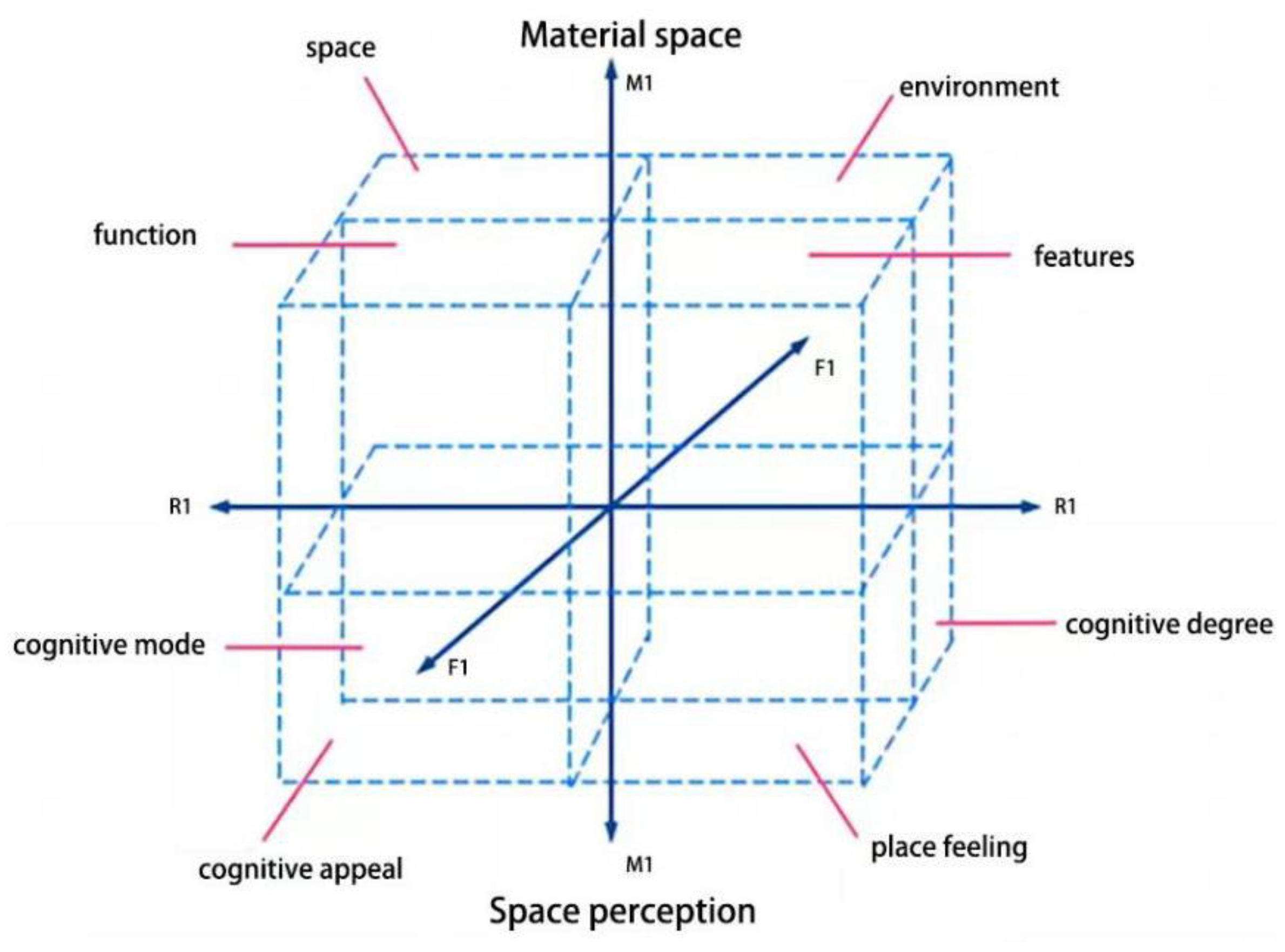

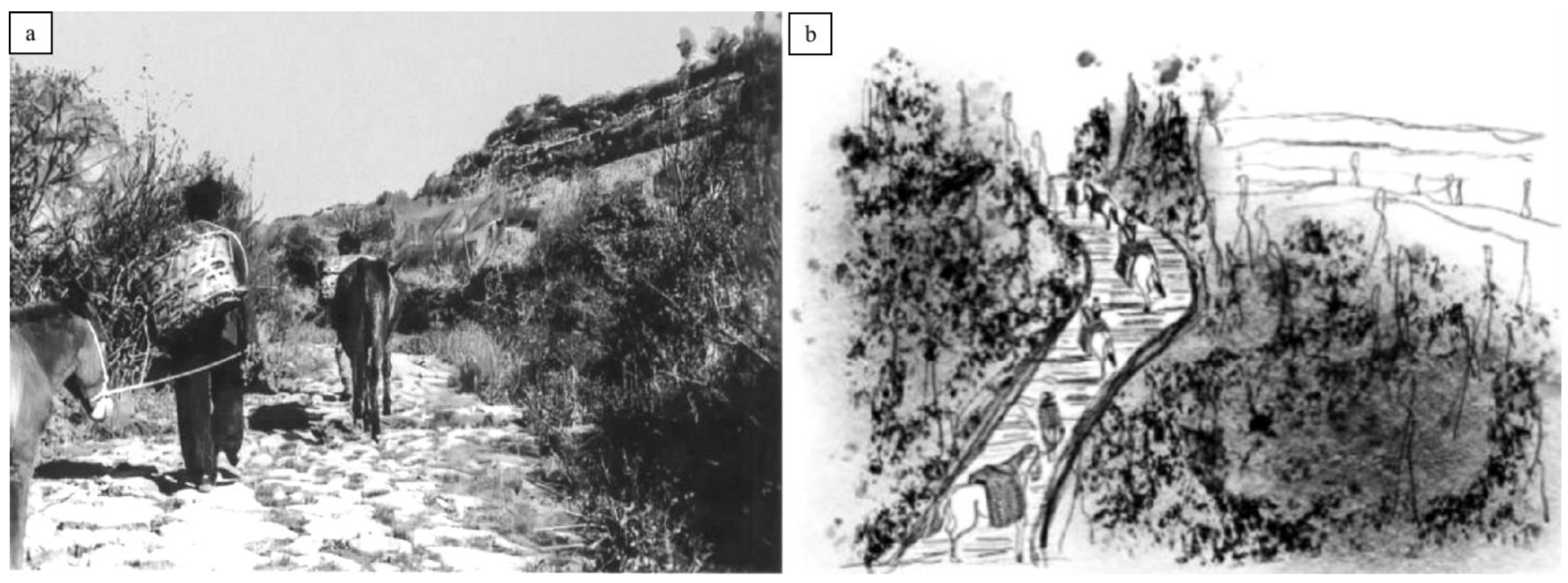
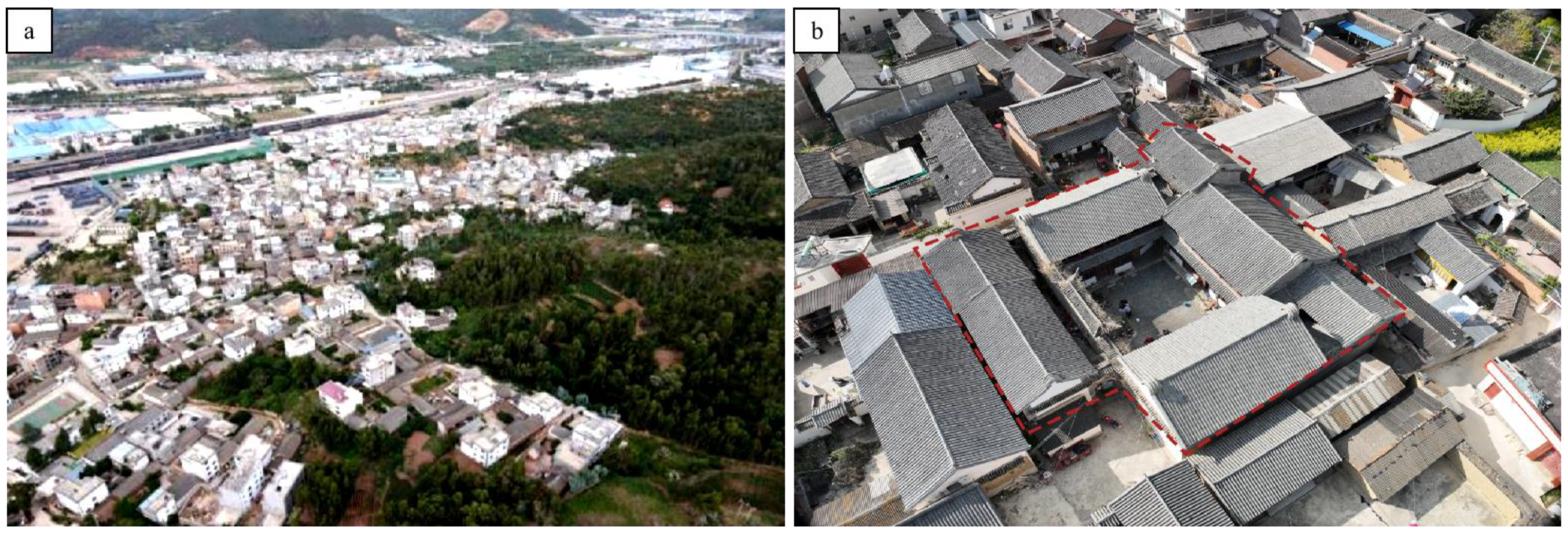
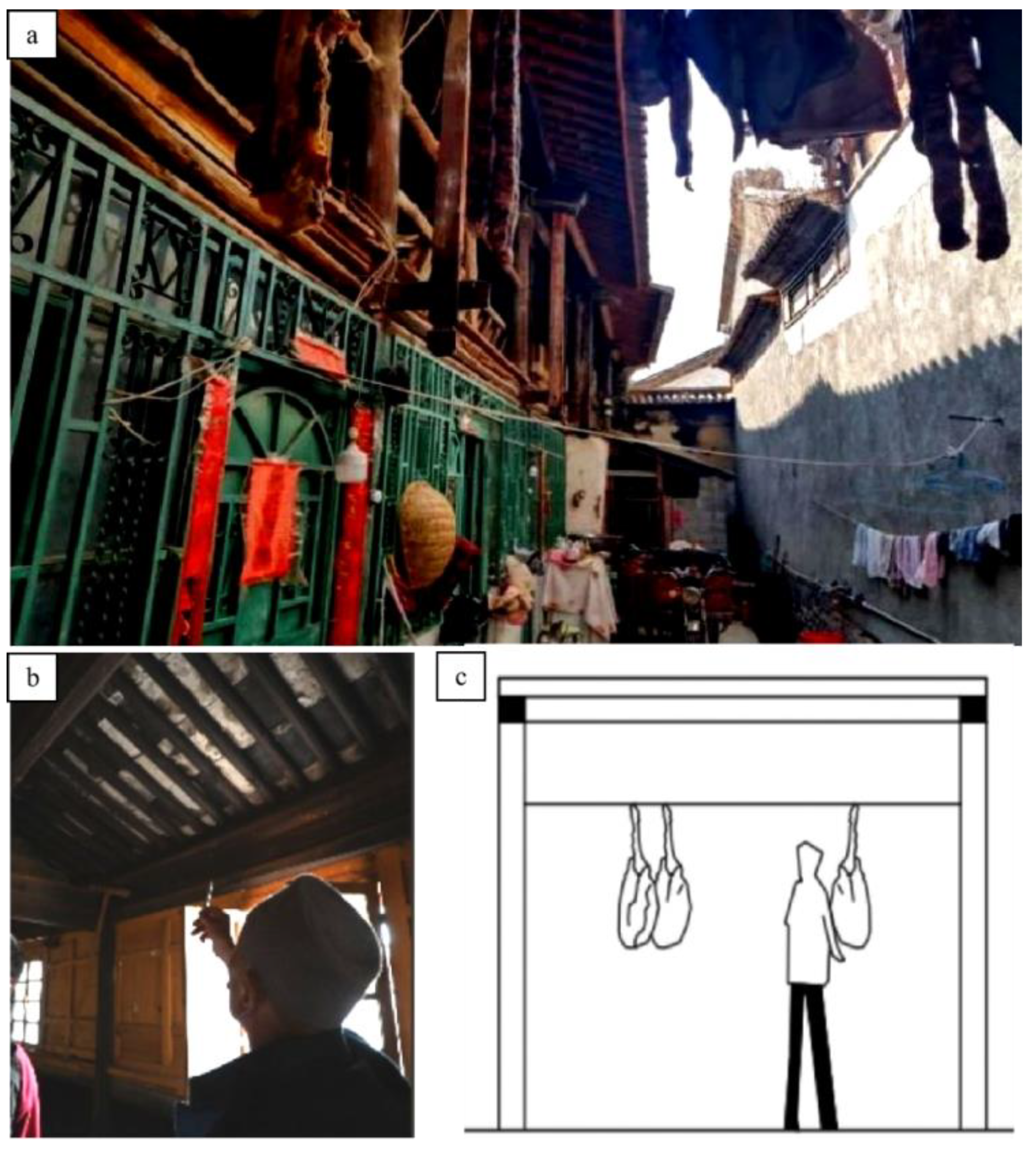

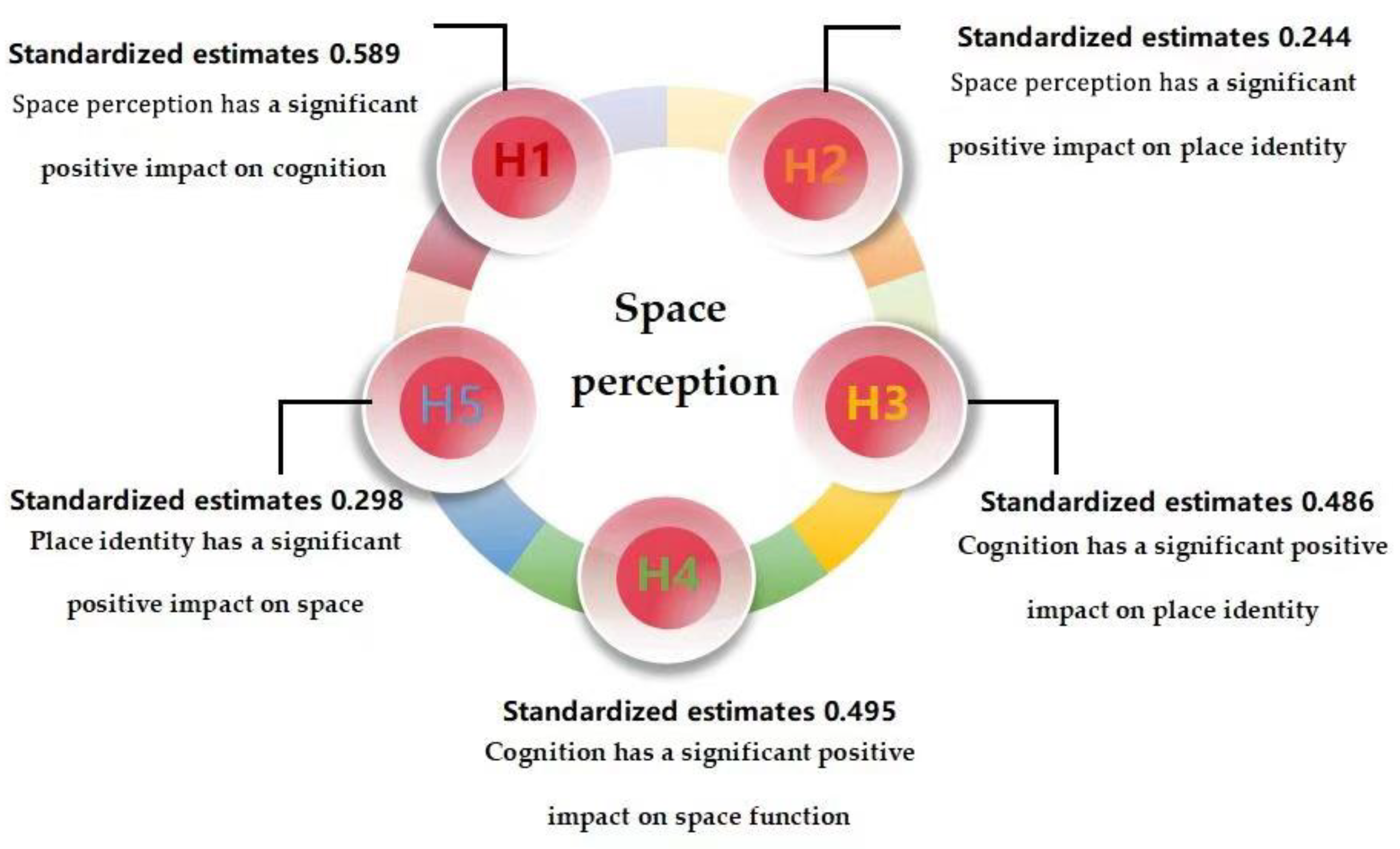
| Variable | Project type | Proportion/% | Variable | Project Type | Proportion/% |
|---|---|---|---|---|---|
| Age/year | 26~35 36~45 46~60 >60 | 38.02 10.05 25.17 16.55 | Family revenue | Farming | 26.70 |
| Working | 33.17 | ||||
| Unit | 41.34 | ||||
| Source of questionnaire | Acquaintances issued Network transmission Friend introduction | 28.60 31.27 49.54 | |||
| Abode | Central urban area | 54.60 | |||
| Suburban binding area | 21.579 | ||||
| Zhihua Village | 23.51 | ||||
| Standard of culture | Junior high school and below | 38.94 | Questionnaire time | 5–10 min | 33.16 |
| High school (technical secondary school) | 26.32 | 10–30 min | 31.68 | ||
| Bachelor’s degree (junior college) | 36.04 | Unclear | 36.36 |
| Tag Type/Mass | Historical Landscape | Historical Architecture | Function Space | Renovated Space |
|---|---|---|---|---|
| Local people | 26% | 23% | 18% | 14% |
| Visitors | 28% | 12% | 9% | 23% |
| Hypothesis Number | Influence Path | Hypothesis Content |
|---|---|---|
| H1 | Space perception–cognition degree | Space perception has a significant positive impact on cognition. |
| H2 | Space perception–local identity | Space perception has a significant positive impact on place identity. |
| H3 | Cognition degree–local identity | Cognition has a significant positive impact on place identity. |
| H4 | Cognition degree–space function | Cognition has a significant positive impact on space function. |
| H5 | Local identity–space appeal | Place identity has a significant positive impact on spatial appeal. |
| Model Construct | Code | Measurement Items | Literature Resources | |
|---|---|---|---|---|
| Space perception | Horse caravan history | EE1 | Do you know the history of the horse caravan architectural heritage? | [40,41,42] |
| EE2 | Do you recognise the history and cultural development of the Crowd of Horsemen? | |||
| EE3 | Do you know the history of horse caravan Village? | |||
| Historical memory | CH1 | You think that space remodeling restores historical memory. | ||
| CH2 | Do you think space has an effect on mental experience? | |||
| CH3 | What do you think of the experience of horse caravan architecture? | |||
| Environmental landscape | LE1 | You think that the horse caravan architecture is integrated with the natural environment. | ||
| LE2 | You think that environmental integration has a more positive impact. | |||
| LE3 | You think the horse caravan architecture materials come from the natural environment. | |||
| Space regeneration | EI1 | You think that the convenience of architectural space layout is better. | ||
| EI2 | You think that the horse caravan architecture does not need to consider modern factors. | |||
| EI3 | You think that the space regeneration of the horse caravan architecture is better than the historical restoration. | |||
| Space function | AC1 | You think that different functions affect the cognition and evaluation of the horse caravan architecture. | [43,44] | |
| AC2 | You are very interested in participating in the process of protecting the function of the horse caravan architecture. | |||
| AC3 | You think that the spatial detail design has a great influence on the aesthetics of the whole architecture. | |||
| AC4 | You pay attention to the decoration and detail design of the horse caravan architecture. | |||
| Cognition degree | SA1 | You have a higher awareness of the life of the horse caravan architecture. | [45,46] | |
| SA2 | You think the horse caravan architecture will meet the changing horse caravan life. | |||
| SA3 | You think the traditional style of the horse caravan architecture is suitable for the needs of modern life. | |||
| Local identity | LI1 | You are willing to participate in the protection of the horse caravan architecture. | [47,48] | |
| LI2 | You think the repair work is well done. | |||
| LI3 | You understand that the horse caravan architecture needs regular maintenance and repair. | |||
| LI4 | You think that the horse caravan architecture has educational value. | |||
| Space appeal | RI1 | You think that the horse caravan architecture has strong symbolic characteristics. | [49] | |
| RI2 | You have great support for the renovation and renewal of the horse caravan architecture. | |||
| RI3 | You think that the horse caravan architecture as a cultural symbol shapes the community cohesion. | |||
| Index | Value Ranges | |
|---|---|---|
| Acceptable | No Fit | |
| CMIN/DF | <3.0 | >5.0 |
| GFI | >0.9 | <0.8 |
| AGFI | >0.9 | <0.8 |
| RMSEA | <0.05 | >0.08 |
| NNFI | >0.9 | <0.8 |
| IFI | >0.9 | |
| CFI | >0.9 | <0.8 |
| Indicators of Fitting | Result | Fit or Not |
|---|---|---|
| χ2/df | 1.863 | Fit |
| GFI | 0.913 | Fit |
| AGFI | 0.894 | Fit |
| RMSEA | 0.044 | Fit |
| CFI | 0.957 | Fit |
| NFI | 0.913 | Fit |
| TLI | 0.952 | Fit |
Disclaimer/Publisher’s Note: The statements, opinions and data contained in all publications are solely those of the individual author(s) and contributor(s) and not of MDPI and/or the editor(s). MDPI and/or the editor(s) disclaim responsibility for any injury to people or property resulting from any ideas, methods, instructions or products referred to in the content. |
© 2024 by the authors. Licensee MDPI, Basel, Switzerland. This article is an open access article distributed under the terms and conditions of the Creative Commons Attribution (CC BY) license (https://creativecommons.org/licenses/by/4.0/).
Share and Cite
Chen, H.; Yang, Y.; Zhao, D.; Zhang, L.; Tang, Z.; Tian, J.; Shen, T.; Yin, Y. Social Cluster and Heritage Memory: A Study on the Space Perception of Zhaozhou Basin Horse Caravan Vernacular Architecture. Buildings 2024, 14, 2405. https://doi.org/10.3390/buildings14082405
Chen H, Yang Y, Zhao D, Zhang L, Tang Z, Tian J, Shen T, Yin Y. Social Cluster and Heritage Memory: A Study on the Space Perception of Zhaozhou Basin Horse Caravan Vernacular Architecture. Buildings. 2024; 14(8):2405. https://doi.org/10.3390/buildings14082405
Chicago/Turabian StyleChen, Hongyu, Yi Yang, Difei Zhao, Lanxi Zhang, Zhenjie Tang, Jinhuan Tian, Ting Shen, and Yinghao Yin. 2024. "Social Cluster and Heritage Memory: A Study on the Space Perception of Zhaozhou Basin Horse Caravan Vernacular Architecture" Buildings 14, no. 8: 2405. https://doi.org/10.3390/buildings14082405
APA StyleChen, H., Yang, Y., Zhao, D., Zhang, L., Tang, Z., Tian, J., Shen, T., & Yin, Y. (2024). Social Cluster and Heritage Memory: A Study on the Space Perception of Zhaozhou Basin Horse Caravan Vernacular Architecture. Buildings, 14(8), 2405. https://doi.org/10.3390/buildings14082405







